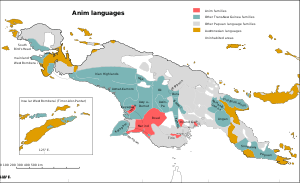Anim languages
The Anim or Fly River languages are a group of Trans–New Guinea families in south-central New Guinea established by Usher & Suter (2015).[2] The names of the family derive from the Fly River and from the Proto-Anim word *anim 'people'.[2]
| Anim | |
|---|---|
| Fly River | |
| Geographic distribution | Fly River, central southern New Guinea |
| Linguistic classification | Trans–New Guinea
|
| Proto-language | Proto-Anim |
| Subdivisions |
|
| Glottolog | anim1240[1] |
 Map: The Anim languages of New Guinea
The Anim families
Other Trans–New Guinea families
Other Papuan languages
Austronesian languages
Uninhabited | |
Languages
The 17 Anim languages belong to the following four subfamilies:[3]
- Inland Gulf
- Tirio (Lower Fly River)
- Boazi (Lake Murray)
- Marind (Marind–Yaqai)
The moribund Abom language, previously considered a member of the Tirio family, is of uncertain classification, possibly Trans–New Guinea, but does not appear to be Anim. The extinct Karami language, attested only in a short word list and previously assigned to the Inland Gulf family, defies classification (Usher and Suter 2015).
Anim languages and respective demographic information listed by Evans (2018) are provided below.[4]
List of Anim languages Language Subgroup Location Population Alternate names Marind Nuclear Marind central Merauke Regency and southeast corner (Indonesia) 7,000 Bian Nuclear Marind northeast Merauke Regency (Indonesia) 2,900 Yaqay Yaqay eastern Mappi Regency (Indonesia) 10,000 Warkay-Bipim Yaqay south Asmat Regency (Indonesia) 300 Kuni-Boazi Lake Murray (Boazi) west Lake Murray (PNG) 4,500 Zimakani Lake Murray (Boazi) southwest Lake Murray across border (PNG) 1,500 Tirio Tirio (Lower Fly) south bank of lower Fly River (PNG) 1900 Makayam Bitur Tirio (Lower Fly) south bank of lower Fly River (PNG) 860 Mutum, Paswam, Bituri Adulu Tirio (Lower Fly) south Gogodala Rural LLG (PNG) 220 Aturu Lewada-Dewara Tirio (Lower Fly) Gogodala Rural LLG (PNG) 700 Were Baramu Tirio (Lower Fly) south bank of lower Fly River (PNG) 850 Ipiko Ipiko (Inland Gulf) West Kikori Rural LLG (PNG)
Reconstruction
Phonemes
| Proto-Anim | |
|---|---|
| Reconstruction of | Anim languages |
Usher (2020) reconstructs the consonant inventory as follows:[5]
*m *n *p *t *k *mb *nd *ŋg *ɸ *s *w *r *j
Vowels are *a *e *i *o *u.
Pronouns
Proto-Anim pronouns (Usher and Suter 2015):[2]
sg pl 1 *na- *ni- 2 *ŋga- *ja 3 *(u)a- *ja
By 2020, comparison with the neighboring TNG branch Awyu–Ok had lead so some revision of the reconstructions. Here are the nominative and possessive/object forms:[5]
sg pl 1 *no, *na- *ni, *na-/*ni- 2 *ŋgo, **ŋga- *[i/e]o, *[i/e]a- 3m *e, *e- *i, *i- 3f *u, *u-
The demonstrative third-person forms *e-, *u-, *i- are an innovation shared with proto-Awyu–Ok, which has the same vowel ablaut in the second person as well. They reflect a gender ablaut of msg *e, fsg *u, nsg *[a/o], and pl *i, as in *anem 'man', *anum 'woman', *anim 'people', or *we 'father', *wu 'mother', *wi 'parents'.[5]
References
- Hammarström, Harald; Forkel, Robert; Haspelmath, Martin, eds. (2017). "Anim". Glottolog 3.0. Jena, Germany: Max Planck Institute for the Science of Human History.
- Timothy Usher and Edgar Suter (2015) "The Anim Languages of Southern New Guinea". Oceanic Linguistics 54:110–142
- https://sites.google.com/site/newguineaworld/families/trans-new-guinea/fly-river
- Evans, Nicholas (2018). "The languages of Southern New Guinea". In Palmer, Bill (ed.). The Languages and Linguistics of the New Guinea Area: A Comprehensive Guide. The World of Linguistics. 4. Berlin: De Gruyter Mouton. pp. 641–774. ISBN 978-3-11-028642-7.
- New Guinea World, Fly River
External links
- Timothy Usher & Edgar Suter, New Guinea World, Proto–Fly River (see also reconstructions of branches)